Sheng Zhao
Exploring the Potential of Large Multimodal Models as Effective Alternatives for Pronunciation Assessment
Mar 14, 2025Abstract:Large Multimodal Models (LMMs) have demonstrated exceptional performance across a wide range of domains. This paper explores their potential in pronunciation assessment tasks, with a particular focus on evaluating the capabilities of the Generative Pre-trained Transformer (GPT) model, specifically GPT-4o. Our study investigates its ability to process speech and audio for pronunciation assessment across multiple levels of granularity and dimensions, with an emphasis on feedback generation and scoring. For our experiments, we use the publicly available Speechocean762 dataset. The evaluation focuses on two key aspects: multi-level scoring and the practicality of the generated feedback. Scoring results are compared against the manual scores provided in the Speechocean762 dataset, while feedback quality is assessed using Large Language Models (LLMs). The findings highlight the effectiveness of integrating LMMs with traditional methods for pronunciation assessment, offering insights into the model's strengths and identifying areas for further improvement.
CosyAudio: Improving Audio Generation with Confidence Scores and Synthetic Captions
Jan 28, 2025Abstract:Text-to-Audio (TTA) generation is an emerging area within AI-generated content (AIGC), where audio is created from natural language descriptions. Despite growing interest, developing robust TTA models remains challenging due to the scarcity of well-labeled datasets and the prevalence of noisy or inaccurate captions in large-scale, weakly labeled corpora. To address these challenges, we propose CosyAudio, a novel framework that utilizes confidence scores and synthetic captions to enhance the quality of audio generation. CosyAudio consists of two core components: AudioCapTeller and an audio generator. AudioCapTeller generates synthetic captions for audio and provides confidence scores to evaluate their accuracy. The audio generator uses these synthetic captions and confidence scores to enable quality-aware audio generation. Additionally, we introduce a self-evolving training strategy that iteratively optimizes CosyAudio across both well-labeled and weakly-labeled datasets. Initially trained with well-labeled data, AudioCapTeller leverages its assessment capabilities on weakly-labeled datasets for high-quality filtering and reinforcement learning, which further improves its performance. The well-trained AudioCapTeller refines corpora by generating new captions and confidence scores, serving for the audio generator training. Extensive experiments on open-source datasets demonstrate that CosyAudio outperforms existing models in automated audio captioning, generates more faithful audio, and exhibits strong generalization across diverse scenarios.
ZSVC: Zero-shot Style Voice Conversion with Disentangled Latent Diffusion Models and Adversarial Training
Jan 08, 2025



Abstract:Style voice conversion aims to transform the speaking style of source speech into a desired style while keeping the original speaker's identity. However, previous style voice conversion approaches primarily focus on well-defined domains such as emotional aspects, limiting their practical applications. In this study, we present ZSVC, a novel Zero-shot Style Voice Conversion approach that utilizes a speech codec and a latent diffusion model with speech prompting mechanism to facilitate in-context learning for speaking style conversion. To disentangle speaking style and speaker timbre, we introduce information bottleneck to filter speaking style in the source speech and employ Uncertainty Modeling Adaptive Instance Normalization (UMAdaIN) to perturb the speaker timbre in the style prompt. Moreover, we propose a novel adversarial training strategy to enhance in-context learning and improve style similarity. Experiments conducted on 44,000 hours of speech data demonstrate the superior performance of ZSVC in generating speech with diverse speaking styles in zero-shot scenarios.
Continuous Speech Tokens Makes LLMs Robust Multi-Modality Learners
Dec 06, 2024



Abstract:Recent advances in GPT-4o like multi-modality models have demonstrated remarkable progress for direct speech-to-speech conversation, with real-time speech interaction experience and strong speech understanding ability. However, current research focuses on discrete speech tokens to align with discrete text tokens for language modelling, which depends on an audio codec with residual connections or independent group tokens, such a codec usually leverages large scale and diverse datasets training to ensure that the discrete speech codes have good representation for varied domain, noise, style data reconstruction as well as a well-designed codec quantizer and encoder-decoder architecture for discrete token language modelling. This paper introduces Flow-Omni, a continuous speech token based GPT-4o like model, capable of real-time speech interaction and low streaming latency. Specifically, first, instead of cross-entropy loss only, we combine flow matching loss with a pretrained autoregressive LLM and a small MLP network to predict the probability distribution of the continuous-valued speech tokens from speech prompt. second, we incorporated the continuous speech tokens to Flow-Omni multi-modality training, thereby achieving robust speech-to-speech performance with discrete text tokens and continuous speech tokens together. Experiments demonstrate that, compared to discrete text and speech multi-modality training and its variants, the continuous speech tokens mitigate robustness issues by avoiding the inherent flaws of discrete speech code's representation loss for LLM.
Investigating Neural Audio Codecs for Speech Language Model-Based Speech Generation
Sep 06, 2024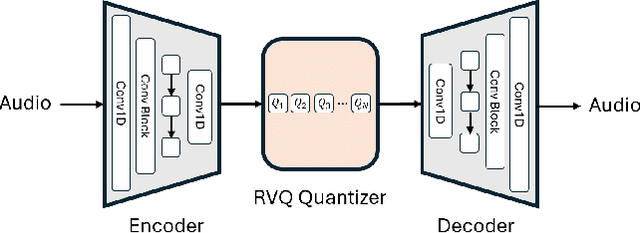
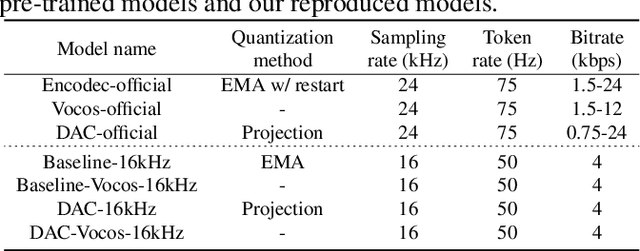
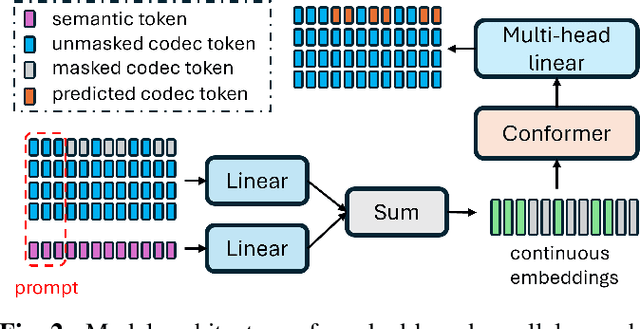
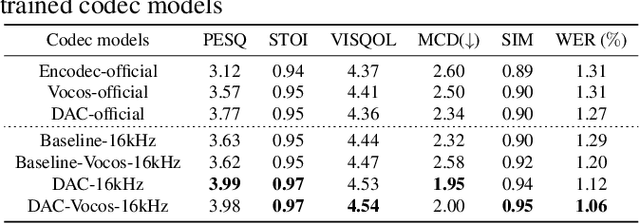
Abstract:Neural audio codec tokens serve as the fundamental building blocks for speech language model (SLM)-based speech generation. However, there is no systematic understanding on how the codec system affects the speech generation performance of the SLM. In this work, we examine codec tokens within SLM framework for speech generation to provide insights for effective codec design. We retrain existing high-performing neural codec models on the same data set and loss functions to compare their performance in a uniform setting. We integrate codec tokens into two SLM systems: masked-based parallel speech generation system and an auto-regressive (AR) plus non-auto-regressive (NAR) model-based system. Our findings indicate that better speech reconstruction in codec systems does not guarantee improved speech generation in SLM. A high-quality codec decoder is crucial for natural speech production in SLM, while speech intelligibility depends more on quantization mechanism.
Laugh Now Cry Later: Controlling Time-Varying Emotional States of Flow-Matching-Based Zero-Shot Text-to-Speech
Jul 17, 2024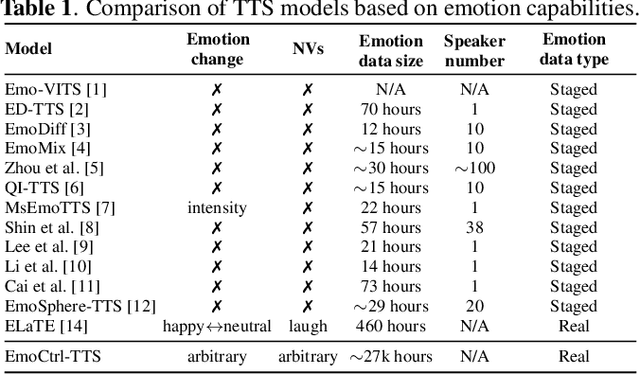


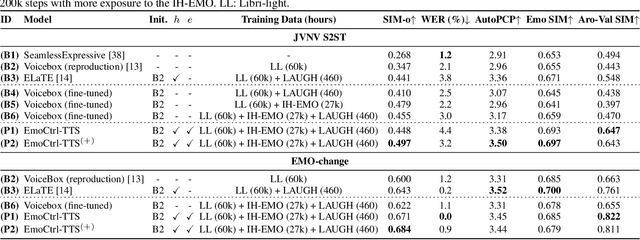
Abstract:People change their tones of voice, often accompanied by nonverbal vocalizations (NVs) such as laughter and cries, to convey rich emotions. However, most text-to-speech (TTS) systems lack the capability to generate speech with rich emotions, including NVs. This paper introduces EmoCtrl-TTS, an emotion-controllable zero-shot TTS that can generate highly emotional speech with NVs for any speaker. EmoCtrl-TTS leverages arousal and valence values, as well as laughter embeddings, to condition the flow-matching-based zero-shot TTS. To achieve high-quality emotional speech generation, EmoCtrl-TTS is trained using more than 27,000 hours of expressive data curated based on pseudo-labeling. Comprehensive evaluations demonstrate that EmoCtrl-TTS excels in mimicking the emotions of audio prompts in speech-to-speech translation scenarios. We also show that EmoCtrl-TTS can capture emotion changes, express strong emotions, and generate various NVs in zero-shot TTS. See https://aka.ms/emoctrl-tts for demo samples.
Autoregressive Speech Synthesis without Vector Quantization
Jul 11, 2024Abstract:We present MELLE, a novel continuous-valued tokens based language modeling approach for text to speech synthesis (TTS). MELLE autoregressively generates continuous mel-spectrogram frames directly from text condition, bypassing the need for vector quantization, which are originally designed for audio compression and sacrifice fidelity compared to mel-spectrograms. Specifically, (i) instead of cross-entropy loss, we apply regression loss with a proposed spectrogram flux loss function to model the probability distribution of the continuous-valued tokens. (ii) we have incorporated variational inference into MELLE to facilitate sampling mechanisms, thereby enhancing the output diversity and model robustness. Experiments demonstrate that, compared to the two-stage codec language models VALL-E and its variants, the single-stage MELLE mitigates robustness issues by avoiding the inherent flaws of sampling discrete codes, achieves superior performance across multiple metrics, and, most importantly, offers a more streamlined paradigm. See https://aka.ms/melle for demos of our work.
E2 TTS: Embarrassingly Easy Fully Non-Autoregressive Zero-Shot TTS
Jun 26, 2024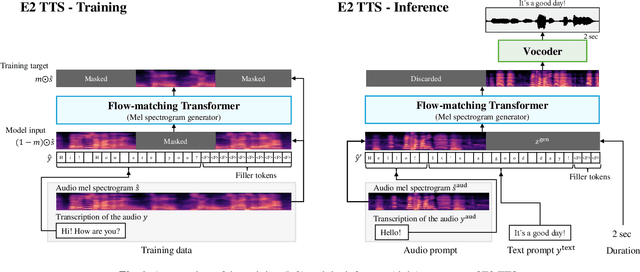
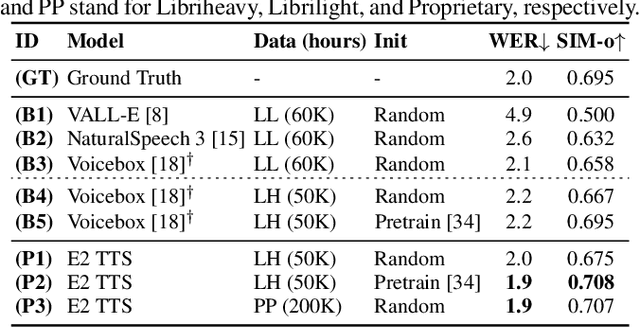
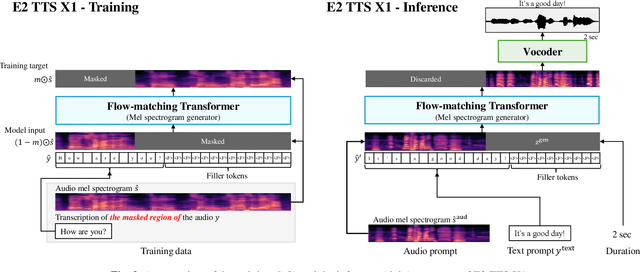
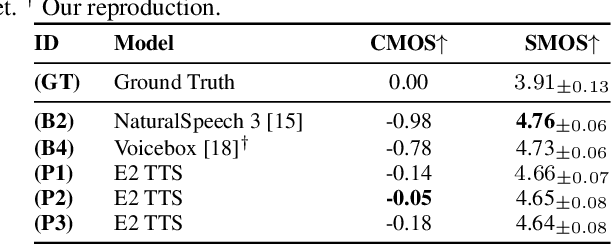
Abstract:This paper introduces Embarrassingly Easy Text-to-Speech (E2 TTS), a fully non-autoregressive zero-shot text-to-speech system that offers human-level naturalness and state-of-the-art speaker similarity and intelligibility. In the E2 TTS framework, the text input is converted into a character sequence with filler tokens. The flow-matching-based mel spectrogram generator is then trained based on the audio infilling task. Unlike many previous works, it does not require additional components (e.g., duration model, grapheme-to-phoneme) or complex techniques (e.g., monotonic alignment search). Despite its simplicity, E2 TTS achieves state-of-the-art zero-shot TTS capabilities that are comparable to or surpass previous works, including Voicebox and NaturalSpeech 3. The simplicity of E2 TTS also allows for flexibility in the input representation. We propose several variants of E2 TTS to improve usability during inference. See https://aka.ms/e2tts/ for demo samples.
VALL-E R: Robust and Efficient Zero-Shot Text-to-Speech Synthesis via Monotonic Alignment
Jun 12, 2024Abstract:With the help of discrete neural audio codecs, large language models (LLM) have increasingly been recognized as a promising methodology for zero-shot Text-to-Speech (TTS) synthesis. However, sampling based decoding strategies bring astonishing diversity to generation, but also pose robustness issues such as typos, omissions and repetition. In addition, the high sampling rate of audio also brings huge computational overhead to the inference process of autoregression. To address these issues, we propose VALL-E R, a robust and efficient zero-shot TTS system, building upon the foundation of VALL-E. Specifically, we introduce a phoneme monotonic alignment strategy to strengthen the connection between phonemes and acoustic sequence, ensuring a more precise alignment by constraining the acoustic tokens to match their associated phonemes. Furthermore, we employ a codec-merging approach to downsample the discrete codes in shallow quantization layer, thereby accelerating the decoding speed while preserving the high quality of speech output. Benefiting from these strategies, VALL-E R obtains controllablity over phonemes and demonstrates its strong robustness by approaching the WER of ground truth. In addition, it requires fewer autoregressive steps, with over 60% time reduction during inference. This research has the potential to be applied to meaningful projects, including the creation of speech for those affected by aphasia. Audio samples will be available at: https://aka.ms/valler.
An Investigation of Noise Robustness for Flow-Matching-Based Zero-Shot TTS
Jun 09, 2024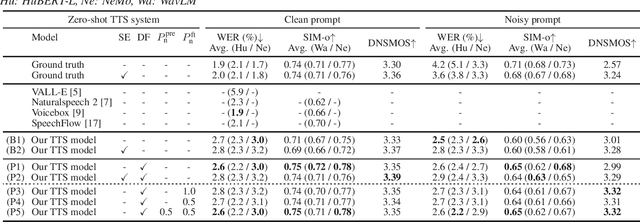
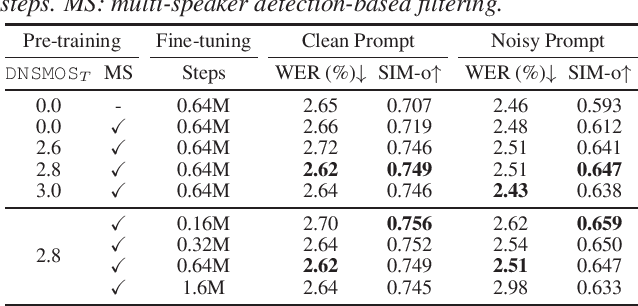
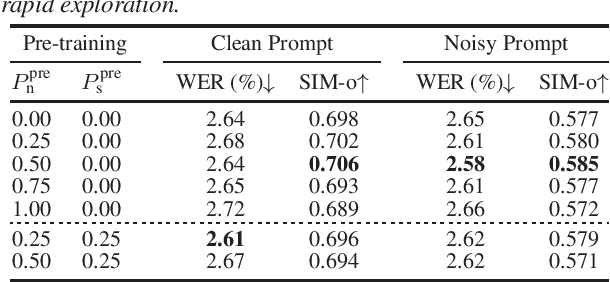
Abstract:Recently, zero-shot text-to-speech (TTS) systems, capable of synthesizing any speaker's voice from a short audio prompt, have made rapid advancements. However, the quality of the generated speech significantly deteriorates when the audio prompt contains noise, and limited research has been conducted to address this issue. In this paper, we explored various strategies to enhance the quality of audio generated from noisy audio prompts within the context of flow-matching-based zero-shot TTS. Our investigation includes comprehensive training strategies: unsupervised pre-training with masked speech denoising, multi-speaker detection and DNSMOS-based data filtering on the pre-training data, and fine-tuning with random noise mixing. The results of our experiments demonstrate significant improvements in intelligibility, speaker similarity, and overall audio quality compared to the approach of applying speech enhancement to the audio prompt.
 Add to Chrome
Add to Chrome Add to Firefox
Add to Firefox Add to Edge
Add to Edge